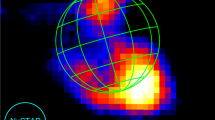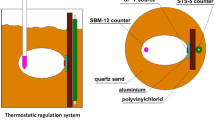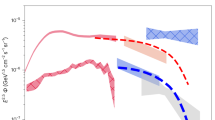Abstract
IN a recent communication to the Physikalische Zeitschrift (No. 18, September) Paschen has described some experiments which indicate that the γ rays from radium supply a large proportion of the total heat emission. It is known that the heating effect of radium when surrounded by an envelope of sufficient thickness to absorb both the α and β rays is about 100 gram calories per hour per gram. Paschen, however, found that if the radium was surrounded by a sufficient amount of lead to absorb completely the γ rays the heating effect was increased 2.26 times. This large heating effect of the γ rays was so unexpected, and of such great importance in connection with the nature of these rays, that we decided to verify this result by an independent method. In Paschen's experiments, the heating effect was determined in a special Bunsen ice calorimeter, in the central tube of which the radium, surrounded by a lead cylinder about 4 cm. in diameter, was placed. In order to correct for the natural melting of the ice mantle a differential method was employed. In our experiments we decided to use a differential air calorimeter, similar to the one described in our previous work on the heating effect of radium and its emanation (Phil. Mag., February). In each flask of the differential air calorimeter there was placed a narrow glass tube, closed at the lower end and extending to about the centre of the flask. The radium bromide weighing 23.7 milligrams was enclosed in a small metal capsule supported by a thread, and was inserted alternately in the glass tubes. The flasks, originally at atmospheric pressure, were immersed in a water bath kept in a constant temperature room, and were connected by a xylene tube which served as a manometer. The heating effect was measured by the movement of the xylene column, observed by a telescope with micrometer oeye-piece, and the scale was calibrated by a small heating coil of approximately the same dimensions as the radium. Two sets of experiments were carried out, in one of which the ends of the glass tubes were inserted in lead cylinders 3 cm. in diameter and 3 cm. high, and in the other with aluminium cylinders of exactly the same dimensions.
This is a preview of subscription content, access via your institution
Access options
Subscribe to this journal
Receive 51 print issues and online access
$199.00 per year
only $3.90 per issue
Buy this article
- Purchase on Springer Link
- Instant access to full article PDF
Prices may be subject to local taxes which are calculated during checkout
Similar content being viewed by others
Author information
Authors and Affiliations
Rights and permissions
About this article
Cite this article
RUTHERFORD, E., BARNES, H. The Heating Effect of the γ Rays from Radium. Nature 71, 151–152 (1904). https://doi.org/10.1038/071151a0
Issue Date:
DOI: https://doi.org/10.1038/071151a0
Comments
By submitting a comment you agree to abide by our Terms and Community Guidelines. If you find something abusive or that does not comply with our terms or guidelines please flag it as inappropriate.



